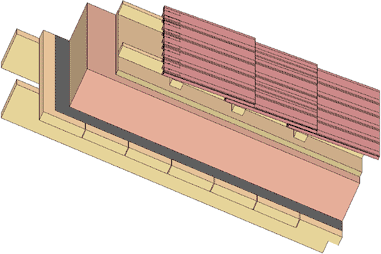Geprüftes/zugelassenes Bauteil
pitched roof sdshzx01-04
pitched roof exposed rafter, ventilated, -, without lining
Building physical assessment
| Fire performance | REI | 30 |
|---|---|---|
|
maximum span = 5 m; maximum load Ed,fi = 5,29 kN/m² (with exposed beams 180/240 and fire protection cladding)
Classified by HFA Classified by HFA
Fire performance Germany
Classification: F30
Load Ed,fi according to the German certification document
Proof: DIN 4102-4:2016-05, Tabelle 10.24, Zeile 1
|
||
| Thermal performance | U | 0,14 W/(m2K) |
| Diffusion | adequate | |
|
Calculated by TUM
|
||
| Acoustic performance | Rw (C;Ctr) | 44 dB (-3; -8) |
| Ln,w (Cl) | ||
|
Rating by Müller-BBM
|
||
| Mass per unit area | m | 132,7 kg/m2 |
data sheet pitched roof
sdshzx01-04 (pdf, 250 KB)
Note
The design of the under-roof construction and of the counter-battens have to be specified according to the roof pitch and the national requirements.
Only for registered members after logging in.


Register of building materials used for this application, cross-section (from outside to inside)
| Thickness [mm] | Building material | Thermal performance | Reaction to fireklasse EN | ||||
|---|---|---|---|---|---|---|---|
| λ | μ min – max | ρ | c | ||||
| A | concrete roof tile or tiled roof | 2100 | A1 | ||||
| B | 30,0 | spruce wood battens (30/50) | 0,120 | 50 | 450 | 1,600 | D |
| C | 50,0 | spruce wood counter battens (Austria: minimum height 50 mm), Germany 30 mm | 0,120 | 50 | 450 | 1,600 | D |
| D | 22,0 | softboard [045; 250] - rigid underlay | 0,045 | 5 | 250 | 2,100 | E |
| E | 240,0 | mineral wool [040; 180; ≥1000°C] - insulation placed on top of the rafters | 0,040 | 1 | 180 | 1,030 | A1 |
| F | vapour barrier sd≥ 1m | 1000 | |||||
| G | 40,0 | spruce wood tongue and groove, fire protection cladding (Germany minimum 50 mm) | 0,120 | 50 | 450 | 1,600 | D |
| H | construction timber in acc. with structural design | 0,120 | 50 | 450 | 1,600 | D | |
Ecological rating (per m2 construction area)
Details of sustainability rating...
| Global warming potential | Share of renewable Primary Energy | Resources | |||||||||||
|---|---|---|---|---|---|---|---|---|---|---|---|---|---|
| Lifecycle Phase |
GWP-F [kgCO2Äqv.] |
GWP-B [kgCO2Äqv.] |
GWP-T [kgCO2Äqv.] |
PERE [MJ] |
PERM [MJ] |
PERT [MJ] |
PENRE [MJ] |
PENRM [MJ] |
PENRT [MJ] |
AP [kgSO2Äqv.] |
EP [kgPO4Äqv.] |
ODP [kgR11Äqv.] |
POCP [kgEthenÄqv.] |
| A1 - A3 | 84,926 | -63,957 | 20,969 | 140,748 | 664,661 | 805,409 | 1065,956 | 37,094 | 1103,051 | 0,504 | 0,147 | 4.3170831E-6 | 0,206 |
Details of sustainability rating...
| Resources | |||||||||||
|---|---|---|---|---|---|---|---|---|---|---|---|
| Lifecycle Phase |
GWP [kgCO2Äqv.] |
AP [kgSO2Äqv.] |
EP [kgPO4Äqv.] |
ODP [kgR11Äqv.] |
POCP [kgEthenÄqv.] |
PERE [MJ] |
PERM [MJ] |
PERT [MJ] |
PENRE [MJ] |
PENRM [MJ] |
PENRT [MJ] |
| A1 - A3 | -26,591 | 0,331 | 0,050 | 3.29E-6 | 0,033 | 280,625 | 970,390 | 1250,881 | 934,186 | 75,208 | 1009,533 |
| C1 - C4 | 96,465 | 0,013 | 0,011 | 1.37E-7 | 0,002 | 2,985 | -966,267 | -963,282 | 38,025 | -22,146 | 15,879 |
| A1 - C4 | 73,203 | 0,347 | 0,062 | 3.43E-6 | 0,034 | 284,317 | 4,123 | 288,306 | 982,730 | 53,062 | 1035,931 |
Last update 02.08.2023/hfa.eco2soft